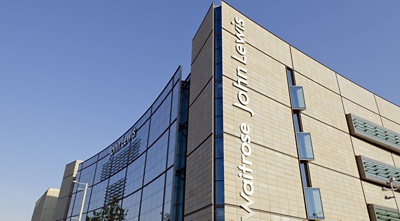Can you tell us about your digital journey before COVID-19, and when the outbreak hit?
The crisis changed everything, and the landscape shifted pretty much overnight. From early March, we were in panic-buying mode. In shops, we literally couldn't keep our shelves filled up fast enough. The rise of online shopping meant that the digital side of our business expanded exponentially. We increased our capacity, both non-food and food for online shopping. I think we will continue to see our online business trading particularly strongly, and the demand for desks, laptops, comfortable clothing, garden furniture, and so on, continues.
We had already made significant digital progress before the outbreak. We had a dispersed office environment, with two campuses across eight office buildings; then overnight, about 8,000 office workers and several hundred contact centre employees worked from home. So that digital transition was instant. They were already online, but they definitely became more digitally enabled. We've only just opened some offices tentatively, but for a small number of people. And so, in the middle of all that, we decided to do what some people may call the definition of crazy and go live with Workday. That digital transformation was hard-going, but it was well worth it. We did everything completely virtually, with the whole team working from home.
You deployed Workday Human Capital Management and Workday Payroll in the midst of the crisis. How has that deployment made a difference in how you manage your people?
A good place to start is with Workday’s mobile optimisation. We've got about 18,000 of our partners furloughed. We've got about 8,000 partners working from home. We've got a couple thousand partners working in a shop that's not the one they normally work in, and we've got our Waitrose teams working flat-out to feed the nation. There are some really practical examples, like being able to see a payslip wherever you are, checking time sheets wherever you are, and changing bank details. We couldn't have done that in such a flexible and agile way with our previous technology platform.
It hasn't been all plain sailing. Our admin support teams have been dealing with more than double the demand, partly because of the crisis and partly because of changes to ways of working. So, we've had our bumps in the road, but we've seen the benefits that we expected from that digitization.
Business, and the way we work, are both likely to change significantly as a result of COVID-19. How do you see that and how will digital influence the way John Lewis Partnership works in the future?
I think it will be a long time before we go back to having 2,200 people in our London head office. I believe we will give much more choice to people on how, where, and when they want to work. It is a shame that it's taken this crisis for businesses to understand how flexibility really can be beneficial in the workplace. I think that office spaces will be reimagined to become places of collaboration, when social distancing allows. And we will continue to rethink our department store model. It's too early to say what that will be like once our customers get used to the new normal. Workday will really support us because of the level of agility and innovation that is embedded in the product.
We’ve already seen this during the crisis, where we repeatedly had to respond quickly to a change to our payroll or a change to time entry for all of those people with different working patterns—that agility from Workday allowed us to do that. This autumn we go live with recruitment, talent, performance, and learning, and these modules mean we’ll have the HR equivalent of a full house. The resourcing module will enable us to recruit more flexibly. We know we're really going to need that with such uncertainty. And the talent module will enable us to spot and develop potential, particularly when people are geographically dispersed.
You deployed Workday at arguably one of the most challenging times. Do you have any advice for organisations looking to transform HR in calmer times?
If you have a large, dispersed population, consider how much effort you want to put into [Workday] training and the resources you think you need, and then double it, because you really will value the investment you make in training people to use Workday quickly. From the point of view of leading a program in uncertain times, when you have to make decisions, look at all the perspectives you can. Take as many bits of advice and insight as possible, then make the best decision you can. Only use hindsight to learn for the future. It was Arthur Conan Doyle, I think, who said, "It's easy to be wise after the event." As a leader, you have to just make the best decisions you can, armed with the data you have at the time.







